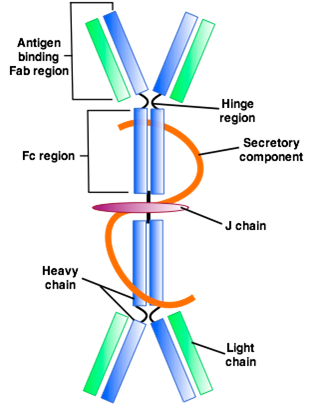BiteSized Immunology: Receptors & Molecules

Immunoglobulin A (IgA)
Immunoglobulin A (IgA) is the first line of defence in the resistance against infection, via inhibiting bacterial and viral adhesion to epithelial cells and by neutralisation of bacterial toxins and virus, both extra- and intracellularly. IgA also eliminates pathogens or antigens via an IgA-mediated excretory pathway where binding to IgA is followed by polyimmunoglobulin receptor-mediated transport of immune complexes.
Secretory Immunoglobulin A (SIgA) has an important role in mediating the adaptive (antigen specific) humoral (antibody [Ab]-based) immune defence at mucosal surfaces (gastrointestinal, respiratory and urogenital tracts). Mucosal surfaces are the portal of entry of many pathogens. SIgA is produced excessively at mucosal surfaces and is the predominant class of Ig found in human external secretions and in tears.
IgA are glycoproteins and one of five classes of Ab. Ab classes are defined by (i) the number of Y-like units (comprised of 4 polypeptides, 2 identical heavy chains and 2 identical light chains) (See Figure 1) and (ii) the type of heavy chain (in the case of IgA, an a-chain). IgA can be oligomeric, comprised of 2–4 IgA monomers.

SIgA is always oligomeric in structure, primarily dimeric, and the polymers are linked by additional polypeptide chains, including a 15KD joining chain (J chain) and a 70KD secretory component chain produced in epithelial cells and involved in the transcellular transport of SIgA (See Figure 1).
In humans, following antigen presentation to T helper cells (Th), and differentiation of Th to Th2, the cytokines interleukin (IL)-10, IL-4 and transforming growth factor beta (TGF)–b are involved in causing the preferential maturation of B cells (B-cell Ab class-switching and differentiation) into B cells that are committed to producing IgA. In humans there are two types of IgA, predominantly IgA1, found in serum and derived in bone marrow, and IgA2, a secretory form of IgA.
© The copyright for this work resides with the author.
